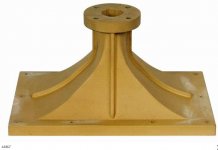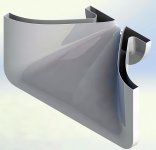This is a Sony magazine advertisement for drivers from almost 50 years ago.
Both build quality and specifications can stand the comparison with the best drivers of this era.
Indeed! Even Sony's mobile audio coax's were built like tanks and performed well enough that after my cache of used Motorola, etc., components dried up it's all I would use to replace vehicle speakers and DIY inexpensive kid's rooms, apt., etc., speakers.
I still have one pair of 6" coax that have frozen up over time, but with wintergreen having skyrocketed in price way more than inflation, doubt I'll try to soften them up unless something cheap will do it.
GM
Except that an OS profile has to be round.
Is an elliptical oblate spheroid or super elliptical oblate spheroid not an 'OS' profile? 😕
Gentelman,
I would like to make test print on 500x400x400 bed. This will be 1mm wall skin with foam inside. Please deceide on waveguide/horn type you need.
I would like to make test print on 500x400x400 bed. This will be 1mm wall skin with foam inside. Please deceide on waveguide/horn type you need.
Gentelman,
I would like to make test print on 500x400x400 bed. This will be 1mm wall skin with foam inside. Please deceide on waveguide/horn type you need.
Why not have a go at Marcel’s horn but 80x80º, 1.4" (35.6mm), 3° entry angle.
Is an elliptical oblate spheroid or super elliptical oblate spheroid not an 'OS' profile? 😕
Strictly speaking, no. There is only one true OS profile and it is axisymmetric.
What I have stated many times is that all coordinate forms that allow for "waveguides" share one unique thing in common. That is that each of them (Elliptic Cylinder, Oblate Spheroidal, Prolate Spheroidal and Ellipsoidal) all share one characteristic. Any ray along the bounding surface must have the same equation as the OS (which has all rays identical.)
The profile that was shown will not fit this requirement for any ray except in the horizontal or vertical planes. I don't know about the other two that you mention, but if they don't abide by the rule above then they will diffract more than one that does.
It is not a coincidence that the OS equation is that of a catenoid between two points at given angles. This means that it will have less diffraction (lowest second derivative) than any other connection between those two points. This is why we know that only waveguides with boundaries of this form will have the lowest possible internal diffraction.
Is there a source for round OS horns for compression drivers? I have read the entire thread but may have missed it.
This is why we know that only waveguides with boundaries of this form will have the lowest possible internal diffraction.
is that equal at all frequencies within the intented band width?
help me out here Doc and i know there is likely a very complex answer but what factor(s) turns a innocent frequency into nasty diffraction??
my inept/incomplete understanding was me wondering where to turn for understanding.
my inept/incomplete understanding was me wondering where to turn for understanding.
Is what "equal"?
Diffraction in a waveguide is, of course, frequency dependent.
Perhaps rephrased as "Does a single OS profile minimize diffraction across all audio frequencies?"
Perhaps rephrased as "Does a single OS profile minimize diffraction across all audio frequencies?"
Yes, if that's the question.
help me out here Doc and i know there is likely a very complex answer but what factor(s) turns a innocent frequency into nasty diffraction??
my inept/incomplete understanding was me wondering where to turn for understanding.
The main factor is the slope of the boundary - the walls. The greater the rate of change the more diffraction there will be. So for a given desire to go from say 4.5 degrees to 45 degrees, one would want the catenoid that does this with a minimum of rate-of-change, and, as I said, this is the OS equation.
I use E-JMLC 300 Horns with JBL 2450s crossed at 800 hz up to 8000 hz outstanding sound. 4 way Active.
ok so what's better a constant rate of change over distance? a rate of change that varies with distance? and does where the greatest rate of change matter where it occurs along the boundary? as in changes quickly at the beginning and remains constant till the boundary limit or conversely does not change greatly until very near the boundary limit.The main factor is the slope of the boundary - the walls. The greater the rate of change the more diffraction there will be.
sorry i don't understand the significance of the angles referenced and i am reading up on catenoid could you please expand on this a little?So for a given desire to go from say 4.5 degrees to 45 degrees, one would want the catenoid that does this with a minimum of rate-of-change, and, as I said, this is the OS equation.
Last edited:
Just bought these JBL 2380 clones for 10euro each.
ARB2" - Bsacoustic.com
With the Radian 760neo bought at a super price from one of the inmates here, it souds super good crosssed at 500hz to a FaitalPro18hf500.
No eq no filter, 30cm measurement.
radian760neo-jbl2380-near-no-EQ — imgbb.com
Some IIR eq and filter
radian760neo-jbl2380-IIR-EQ — imgbb.com
I don't know if I need the third way yet, I ordered some Beyma supertweeters but as they are now, 2 way sounds great, my hearing is done at 14k4 anyway.
ARB2" - Bsacoustic.com
With the Radian 760neo bought at a super price from one of the inmates here, it souds super good crosssed at 500hz to a FaitalPro18hf500.
No eq no filter, 30cm measurement.
radian760neo-jbl2380-near-no-EQ — imgbb.com
Some IIR eq and filter
radian760neo-jbl2380-IIR-EQ — imgbb.com
I don't know if I need the third way yet, I ordered some Beyma supertweeters but as they are now, 2 way sounds great, my hearing is done at 14k4 anyway.
A coinstant rate is a conical horn defined in a spherical coordinate system. This shape has no internal diffraction, but only if it is fed by a spherical wavefront. No compression drivers have this kind of exit wavefront and I would suggest that beyond infeasible, it might be very difficult to impossible.ok so what's better a constant rate of change over distance? a rate of change that varies with distance?
No it does not. There is only one shape that is optimal and it is defined, so it is what it is.and does where the greatest rate of change matter where it occurs along the boundary? as in changes quickly at the beginning and remains constant till the boundary limit or conversely does not change greatly until very near the boundary limit.
sorry i don't understand the significance of the angles referenced and i am reading up on catenoid could you please expand on this a little?
Most drivers exit at 4.5 degrees or so, hence the first number. I like 90 degree coverage waveguides so the second number is half that or 45 degrees.
Wow!! 🙂 What substance is it made of 😕Just bought these JBL 2380 clones for 10euro each.
ARB2" - Bsacoustic.com
Attachments
Why not have a go at Marcel’s horn but 80x80º, 1.4" (35.6mm), 3° entry angle.
We are trying find solution how to make waveguide with minimum set of points and should be ready till Monday.
Attachments
- Home
- Loudspeakers
- Multi-Way
- 1.4" or 2" throat large constant directivity horns you can actually buy!

